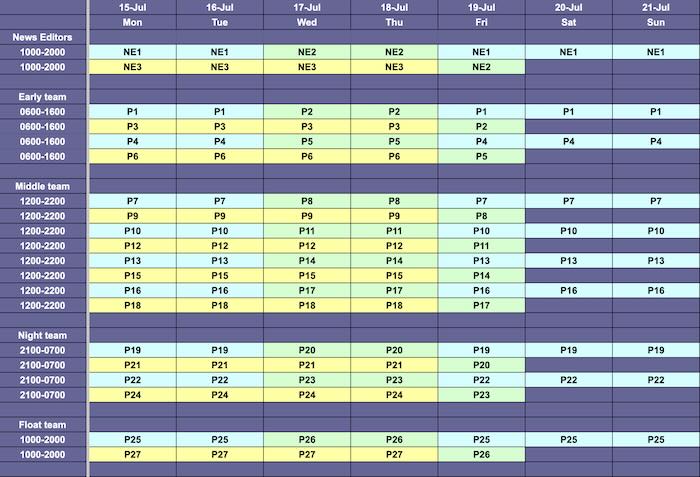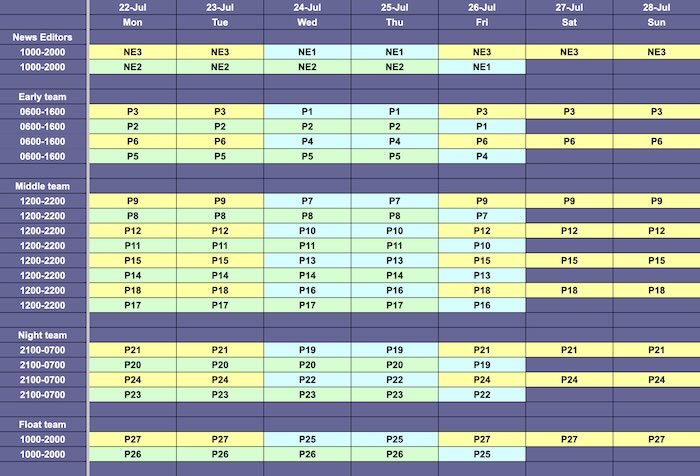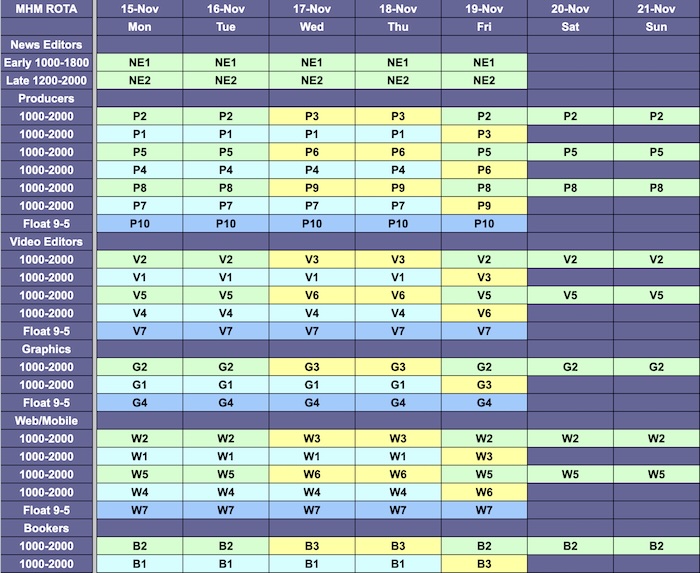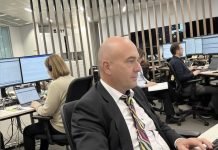 Every news operations needs a staffing rota that provides excellent coverage during operational hours, makes maximum use of resources, and offers significant benefits for staff.
Every news operations needs a staffing rota that provides excellent coverage during operational hours, makes maximum use of resources, and offers significant benefits for staff.
A newsroom rota needs to focus effort on the peak output times of the day, have capacity to respond to large unexpected breaking news situations, and have capacity for forward planning and the production of in-depth background material.
Managers need to ensure that all staff are fresh and rested for their shifts and that they are well-briefed up to speed with the latest developments. The following news rota pattern does just that.
It was devised by the founders of Media Helping Media and has been adapted and used by leading international, national and regional publishers and broadcasters worldwide as well as smaller media organisations.
The two sample rotas below are based on a three-week repeating pattern. The first is for a website, the second is for the online output from a converged newsroom.
Each rota pattern can be adapted according to available resources, output needs, and audience demand. The smallest news outlets we have built it for are an online news startup in the Middle East with six staff.
The 10-hour shift covering 24-hours
The rota pattern below is for a 24-hour rolling news operation. It’s based on staff working an average 40-hour week over a three-week rotating schedule.
The rota is designed to ensure continuous coverage with built-in overlap between shifts for effective handovers and peak-time support.
In the three graphics below the colours blue, green and yellow are used to show each sequence of shifts. These can be repeated or removed depending on need.
On the left are the roles – these will change depending on the type of news business you are in and the roles and responsibilities involved.
The codes – P1, P2, P3 etc are simply where you would place the initials of the staff members on shift.
They also represent roles – so, for example, in the patterns below you might want to allocate the three shifts P13 to P15 to background feature writing, and the shifts P16 to P17 to forward planning for upcoming events.



How it works
Over the course of the three weeks the repeating pattern means that staff will:
- Work one four-day week
- Work one five-day week
- Work one three-day week.
- They will work one weekend in three
- They will have one long weekend off in three (Friday, Saturday, Sunday)
- There is a ‘float’ shift for covering staff illness, leave, or periods of high demand.
- No more than two people can be off at any time (if you want to allow more people off at the same time you will need to add another line to the float).
Why the 10-hour rota is effective
- Continuous 24/7 Coverage: The rota ensures that all hours are covered with maximum effort focused on expected peak times.
- Predictability and fairness: The pattern is easy to understand and plan around, with predictable days off and a fair distribution of night and weekend shifts.
- Employee satisfaction: The extra day off and longer rest periods contribute to higher job satisfaction and lower burnout rates.
- Operational efficiency: Overlap periods allow for effective handovers, minimising errors and ensuring continuity of service.
Download the rota
To adapt and use this rota pattern do the following:
- Click here to download a spreadsheet version of the rota
- Save the dowloaded rota as a ‘master’ copy (in case you make any mistakes).
- Adapt it to your own needs by using ‘find & replace’ to:
- Change the dates at the top of the rota
- Change the names of the shifts you require
- Delete any groups of the three coloured shift patterns depending on your own resources and needs
- Copy and repeat groups of the three coloured shift patterns if you want to expand the rota
- Rename the shifts and roles as you wish
- Give the rota a name and save it
Converged news operation – broadcast and online
If you are a broadcaster with a 24-hour news cycle you might want to consider an expanded version of our rota designed for a fully converged news operation.
The following rota included 8-hour shifts for senior day editors, shifts for video editors, graphic editors, and guest bookers as well as newsroom journalists.
In this pattern the float shift (for holiday and sick leave) is an 8-hour shift.



You can download a copy of this expanded rota by clicking here.
How it works
The rotas were produced from a mathematical model which is fairly simple to use, once you understand the principles behind it.
Let us create a simple example. Say you have 12 members of staff. Each will work four ten-hour shifts a week, giving a total of 48 shifts available.
It is not practical to immediately allocate all of those 48 shifts to cover the news properly – because some of time members of staff will be on holiday or off sick. To allow for this you should calculate that each member of staff is available only 85 per cent of the time.
So instead of having 48 shifts available for your core operation, you have only 40. (If everyone is available on any particular week, they should all be scheduled but eight of the shifts should be non-essential – in other words the work will still get done if they are not present.)
So now you have 40 shifts available each week. You want to spread the work fairly and you want your 12 staff to be able to plan their lives, so you need a predictable work pattern.
You then find the lowest common multiple for these two numbers, 40 and 12. The lowest common multiple is 120 – which converts into three weeks of shifts.
You are now in a position to construct a three-week repeating work rota which should operate successfully and sustainably.
- Variables
- S = Number of staff members
- H = Shifts each staff member works per week
- A = Availability factor (e.g., 0.85 for 85% availability)
- T = Required core shifts per week (essential coverage)
Formula steps
- Total shifts (without adjustments) – Calculate all potential shifts if everyone worked 100% of the time:
- Total Shifts = S × H
- Core shifts (adjusted for availability) – Calculate shifts actually available for essential coverage:
- Core Shifts = Total Shifts × A
- Spare shifts – Calculate shifts reserved as a buffer for holidays/sickness:
- Spare Sifts = Total Shifts − Core Shifts
- Coverage check – Ensure core shifts meet or exceed required shifts:
- Core Shifts ≥ T
If not, adjust S, H, or A.
- Core Shifts ≥ T
- Rota calculation – Find the smallest repeating schedule using the Lowest Common Multiple (LCM) of staff (S) and required shifts (T):
- Rota Cycle (weeks) = LCM(S, T) ÷ T
Example
- S = 12 staff
- H = 4 shifts/staff/week
- A = 0.85 (85% availability)
- T = 40 core shifts needed
Calculations
- Total Shifts = 12 × 4 = 48
- Core Shifts = 48 × 0.85 = 40.8 (≈40 for practical purposes)
- Spare Shifts = 48 − 40 = 8
- Rota Cycle = LCM(12, 40) ÷ 40 = 120 ÷ 40 = 3 weeks
Summary formula
- Total Shifts = S × H
- Core Shifts = Total Shifts × A
- Spare Shifts = Total Shifts − Core Shifts
- Rota Cycle (weeks) = LCM(S, T) ÷ T
This ensures:
- Core shifts – cover essential operations.
- Spare shifts – act as a buffer for staff absences.
- A repeating rota – (e.g., 3 weeks) balances fairness and predictability.








